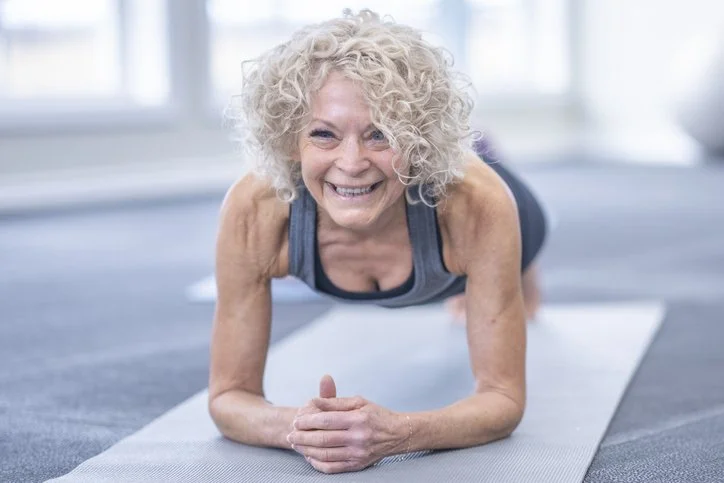Thin, Not Frail: How to Stay Lean and Protect Your Bones Too
By Joy Stephenson-Laws, Holistic Coach, J.D., Founder
In a culture that often praises being slim, it can be easy to assume that “skinnier is healthier”—at any age. But for adults over 60, being too thin can actually be a risk, not a benefit.
While maintaining a healthy weight is important, being underweight in later life can lead to serious health concerns—especially when it comes to bone density and fracture risk.
Let’s explore why, and what you can do to stay strong, balanced, and healthy in the years ahead.
What Does It Mean to Be Underweight?
Doctors typically use Body Mass Index (BMI) to assess weight ranges:
Underweight = BMI under 18.5
Normal weight = BMI 18.5 to 24.9
Overweight = BMI 25 to 29.9
Obese = BMI 30 and above
However, BMI isn’t perfect, especially for older adults. Some people with “normal” BMI still have low muscle or bone mass. That’s why healthcare professionals also look at muscle strength, nutrition, and overall function—not just weight on a scale.
But here’s what we know: older adults who are significantly underweight, or losing weight unintentionally, are at higher risk of bone loss and fractures.
Why Being Underweight Raises Bone Risk
Lower Estrogen Means Lower Bone Protection
After menopause, women’s bodies produce less estrogen, a hormone that protects bones. In thin women, estrogen levels drop even further, because fat tissue plays a role in estrogen production. This can accelerate bone loss.
Less Fat = Less Cushioning During Falls
People with very low body fat or muscle mass have less natural padding to protect them if they fall. This makes them more likely to break a hip, spine, or wrist.
Nutritional Deficiencies Are Common in Underweight Adults
Being thin can sometimes mean eating too little of the right nutrients. Many older adults don’t get enough:
Calcium (for strong bones)
Vitamin D (helps absorb calcium)
Protein (supports bone and muscle repair)
Magnesium and vitamin K (important for bone metabolism)
Less Muscle = Less Balance = More Falls
Being underweight often means less muscle mass, which affects balance and strength. That increases the risk of falling—and falling is the #1 cause of broken bones in older adults.
Real-Life Stories: When Thinness Backfires
Deborah Copaken: A Shocking Diagnosis at 58
Author and journalist Deborah Copaken considered herself healthy and active at 58. Petite and slim, she had always assumed that being fit and eating well was enough to stay strong.
Then came the shock: a Dexa scan revealed she had the spine of an 80-year-old, with full-blown osteoporosis. Her doctor explained that her low body weight and postmenopausal hormone loss were key contributors.
Deborah now speaks out about the need for earlier screening and awareness, especially for women with small frames who may appear healthy on the outside but are silently losing bone mass inside.
Ann Richards: Strength Through Awareness
Former Texas Governor Ann Richards was known for her sharp wit and energy—but even she was caught off guard when a scan revealed significant bone loss in her 60s. She had already experienced minor fractures and noticed she was getting shorter.
Her doctors pointed to her lean body frame and low estrogen as likely causes. Determined not to let it define her, Richards changed her lifestyle—adding strength training, calcium, and vitamin D to her routine. She also became an advocate for osteoporosis prevention, especially for older women who are slim or losing weight without meaning to.
What the Research Says
A study in the Journal of Bone and Mineral Research found that underweight women over 65 had nearly twice the risk of hip fractures compared to those with a normal BMI.
The World Health Organization also includes being underweight among the most common causes of injury and loss of independence in older age.
Healthy Is the Goal—Not Skinny
After 60, the focus shifts from “looking thin” to staying strong and well-nourished. Here’s how you can support your bones and body:
1. Eat for Bone Strength
Include calcium-rich foods like leafy greens, dairy, almonds, and tofu
Take vitamin D if your doctor recommends it
Prioritize protein at every meal: fish, beans, eggs, poultry, or nuts
Don’t fear healthy fats (avocados, olive oil, fatty fish)
2. Lift to Stay Strong
Strength training builds muscle and supports bone density
Weight-bearing exercises like walking, dancing, and tai chi stimulate bone growth
Balance-focused movement helps prevent falls
3. Check Your Nutrients
Ask for blood tests to assess levels of:
Vitamin D
Calcium
B12
Iron
4. Get a Bone Density Test
Women 65+ and men 70+ should get a DEXA scan
If you’ve experienced fractures, are underweight, or went through early menopause, you may need one sooner
A New Definition of Strength
At this stage in life, strength doesn’t come from shrinking—it comes from nourishing, maintaining, and protecting the body you live in. Thinness may have once felt like power. But now, true power is in resilience, balance, and energy.
So eat well. Move with joy. Stay strong in your bones and in your spirit.
Because being “cool” at 60+ isn’t about size—it’s about stability, strength, and the freedom to keep doing what you love.


